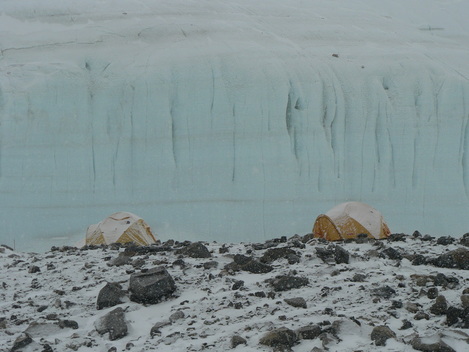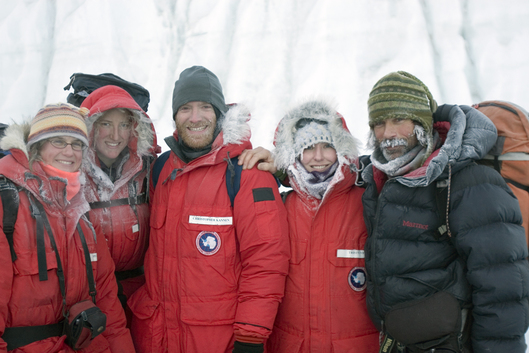Winter Limnology Network
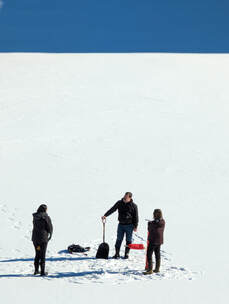
Winter is the fastest warming season in the northern hemisphere. For millions of the world’s seasonally-frozen lakes, this warming means shorter and thinner ice cover and changing patterns of snow accumulation on the ice. Because ice and snow affect many fundamental physical, chemical, and biological properties of lakes, changes in winter conditions can disrupt lake ecosystems and the services they provide to humanity. Until recently, lake scientists paid relatively little attention to winter, meaning we know very little about how lakes work when covered by ice and snow and how winter conditions affect the rest of the year. This leaves scientists ill-prepared to predict how changing winters will impact lakes or to mitigate negative impacts. This study addresses this “winter knowledge gap” and develops a predictive understanding of how winter conditions affect the ecological populations, communities, and food webs of diverse types of lakes. Find out more about the Winter Limnology Network here.
This study is supported by the National Science Foundation (Ozersky: #2306885, Dugan: #2306888, Hampton: #2306886, Sadro: #2306889, Vick-Majors: #2306887).
This study is supported by the National Science Foundation (Ozersky: #2306885, Dugan: #2306888, Hampton: #2306886, Sadro: #2306889, Vick-Majors: #2306887).
Understanding Changing Winters in the Laurentian Great Lakes
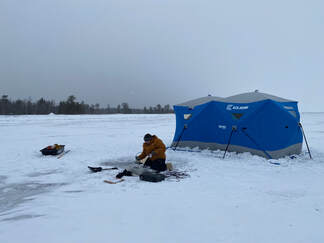
The Laurentian Great Lakes are the world’s largest reservoir of fresh water, but they impacted by multiple interacting stressors, many of which are related to climate change. Winter limnology represents a major gap in our understanding of the lakes’ responses to changing climate, which hampers our ability to manage these systems for resiliency. This research will use a networked science approach to conduct synchronous, standardized sampling across the Great Lakes and Lake St. Clair to assess chemical, physical, and biological limnological aspects of these systems during winter and in subsequent seasons. Using a networked approach will allow us to achieve broad spatial coverage to put winter conditions and ecology in context, and facilitate predictions of future ecosystem responses to changing climate. This project builds off of the first time-synchronized winter sampling to span the Great Lakes, the 2022 Great Lakes Winter Grab. You can read about it on the Michigan Sea Grant website. This project is a collaborative effort between Michigan Tech, Lake Superior State University, Central Michigan University, and Oakland University, funded by Michigan Sea Grant.
Permanently Ice-Covered Lakes in the McMurdo Dry Valleys, Antarctica
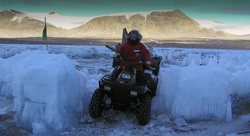
Sir Robert Falcon Scott, upon exploring the one of the Dry Valleys in 1903, called it a "valley of the dead". The mistake was understandable, given the apparently barren landscape of exposed rock, mountain glaciers, and ice covered lakes. But, Scott couldn't have been more wrong. The lakes of the McMurdo Dry Valleys, Antarctica are permanently ice-covered, cold desert oases. In the photo, Dr. Vick-Majors is working at Lake Fryxell during the austral autumn. While watching the Antarctic sun set for the winter, we were able to answer questions about how microorganisms and the biogeochemical cycles they mediate in the lakes, are impacted by the onset of winter darkness.
The projects were conducted in association with the McMurdo LTER, which has been monitoring the Dry Valley lakes since 1993, and was part of the International Polar Year.
The projects were conducted in association with the McMurdo LTER, which has been monitoring the Dry Valley lakes since 1993, and was part of the International Polar Year.
MIRADA
The Microbial Inventory Research Across Diverse Aquatic Long Term Ecological Research Sites (MIRADA LTERs) sampled two of the meromictic, permanently ice-covered lakes in the McMurdo Dry Valleys before and after the sunset. Then, we used massively-parallel, 454-based rRNA gene tag sequencing, to inventory archaeal, bacterial, and eukaryotic components of the microbial communities. Combining this approach with network analysis, we were able to identify organisms and interactions between organisms that are key to ecosystem function during the transition to winter darkness. We identified an autumn "bloom" of arterial phylotypes, which has also been observed in the Southern Ocean, and pinpointed keystone-type species of bacteria. The keystone phylotypes were all related to organisms that are known to behave mixotrophically, suggesting that physiological flexibility is important to the success of organisms in these oligotrophic, seasonally dark lakes. You can read the full paper here.
This work also led to the discovery of a novel ciliate and to new insights into ciliate diversity. You can find it here.
The Microbial Inventory Research Across Diverse Aquatic Long Term Ecological Research Sites (MIRADA LTERs) sampled two of the meromictic, permanently ice-covered lakes in the McMurdo Dry Valleys before and after the sunset. Then, we used massively-parallel, 454-based rRNA gene tag sequencing, to inventory archaeal, bacterial, and eukaryotic components of the microbial communities. Combining this approach with network analysis, we were able to identify organisms and interactions between organisms that are key to ecosystem function during the transition to winter darkness. We identified an autumn "bloom" of arterial phylotypes, which has also been observed in the Southern Ocean, and pinpointed keystone-type species of bacteria. The keystone phylotypes were all related to organisms that are known to behave mixotrophically, suggesting that physiological flexibility is important to the success of organisms in these oligotrophic, seasonally dark lakes. You can read the full paper here.
This work also led to the discovery of a novel ciliate and to new insights into ciliate diversity. You can find it here.
Bacterioplankton during the transition to Polar Night
In spite of the fact that the microbial ecosystems of the McMurdo Dry Valley lakes have been studied for many years as part of the LTER, autumn and winter ecosystem dynamics are not well understood. Due to logistical constraints, research has mainly been limited to the summer months and little is known about ecosystem responses to the onset of winter and subsequent months of darkness. As a part of the 2007-2008 International Polar Year, we were able to collect data as the sun set during the austral fall to better understand the physiological changes that may take place within the ecosystems during the seasonal transition to darkness. My M.S. research focused on the activities of the plankton communities during the change in season, looking specifically at light dependent primary productivity by phytoplankton, an organic carbon source, and bacterial productivity, an organic carbon sink. My work identified physiological shifts in bacterioplankton communities, which suggested that heterotrophic bacterioplankton may shift from active growth to maintenance mode as the sun set. You can read the paper here.
For information on protist communities during the polar night transition, check out this paper and this one.
In spite of the fact that the microbial ecosystems of the McMurdo Dry Valley lakes have been studied for many years as part of the LTER, autumn and winter ecosystem dynamics are not well understood. Due to logistical constraints, research has mainly been limited to the summer months and little is known about ecosystem responses to the onset of winter and subsequent months of darkness. As a part of the 2007-2008 International Polar Year, we were able to collect data as the sun set during the austral fall to better understand the physiological changes that may take place within the ecosystems during the seasonal transition to darkness. My M.S. research focused on the activities of the plankton communities during the change in season, looking specifically at light dependent primary productivity by phytoplankton, an organic carbon source, and bacterial productivity, an organic carbon sink. My work identified physiological shifts in bacterioplankton communities, which suggested that heterotrophic bacterioplankton may shift from active growth to maintenance mode as the sun set. You can read the paper here.
For information on protist communities during the polar night transition, check out this paper and this one.

